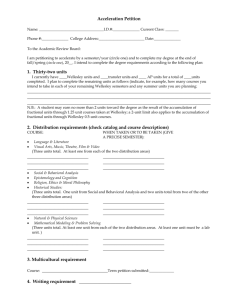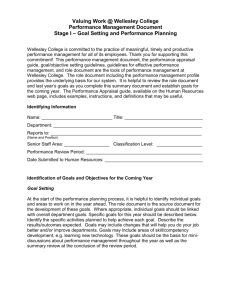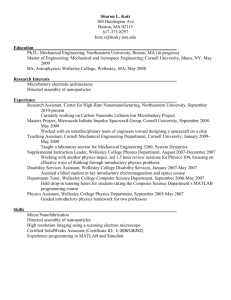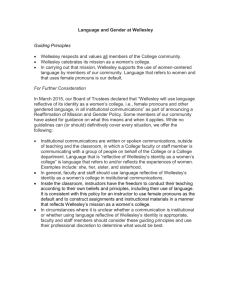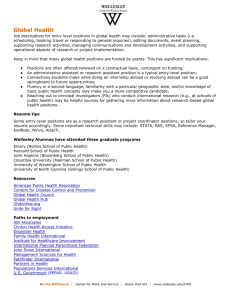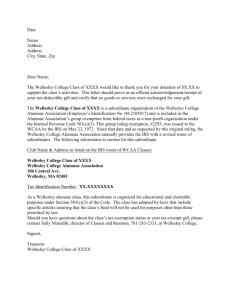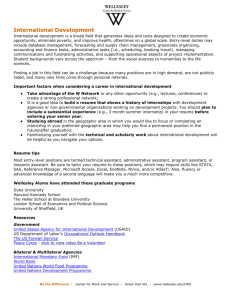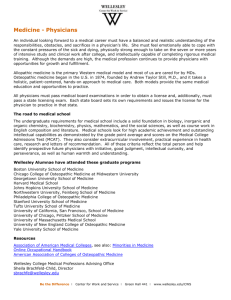Technology and Engineering at Wellesley College: A Case Study
advertisement
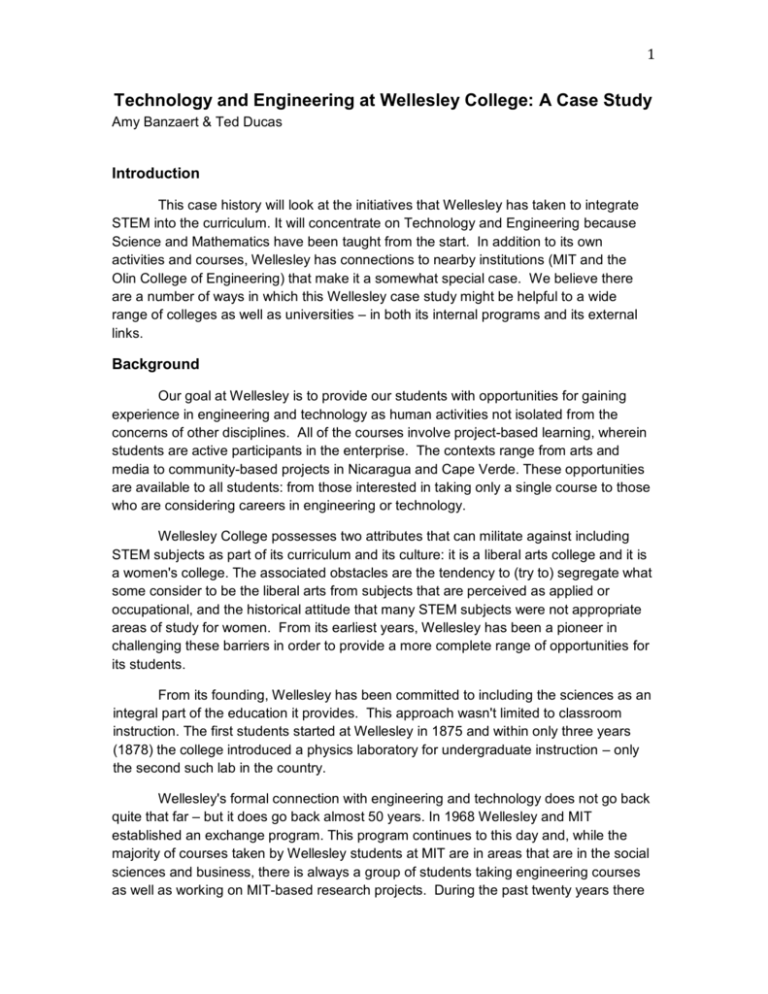
1 Technology and Engineering at Wellesley College: A Case Study Amy Banzaert & Ted Ducas Introduction This case history will look at the initiatives that Wellesley has taken to integrate STEM into the curriculum. It will concentrate on Technology and Engineering because Science and Mathematics have been taught from the start. In addition to its own activities and courses, Wellesley has connections to nearby institutions (MIT and the Olin College of Engineering) that make it a somewhat special case. We believe there are a number of ways in which this Wellesley case study might be helpful to a wide range of colleges as well as universities – in both its internal programs and its external links. Background Our goal at Wellesley is to provide our students with opportunities for gaining experience in engineering and technology as human activities not isolated from the concerns of other disciplines. All of the courses involve project-based learning, wherein students are active participants in the enterprise. The contexts range from arts and media to community-based projects in Nicaragua and Cape Verde. These opportunities are available to all students: from those interested in taking only a single course to those who are considering careers in engineering or technology. Wellesley College possesses two attributes that can militate against including STEM subjects as part of its curriculum and its culture: it is a liberal arts college and it is a women's college. The associated obstacles are the tendency to (try to) segregate what some consider to be the liberal arts from subjects that are perceived as applied or occupational, and the historical attitude that many STEM subjects were not appropriate areas of study for women. From its earliest years, Wellesley has been a pioneer in challenging these barriers in order to provide a more complete range of opportunities for its students. From its founding, Wellesley has been committed to including the sciences as an integral part of the education it provides. This approach wasn't limited to classroom instruction. The first students started at Wellesley in 1875 and within only three years (1878) the college introduced a physics laboratory for undergraduate instruction – only the second such lab in the country. Wellesley's formal connection with engineering and technology does not go back quite that far – but it does go back almost 50 years. In 1968 Wellesley and MIT established an exchange program. This program continues to this day and, while the majority of courses taken by Wellesley students at MIT are in areas that are in the social sciences and business, there is always a group of students taking engineering courses as well as working on MIT-based research projects. During the past twenty years there 2 have been a few students (8 in the past decade) who have taken part in the Five Year Double Degree program. At the end of the 5 years they graduate with undergraduate degrees from both Wellesley and MIT. A larger number of students have taken groups of courses at MIT, graduated in four years with a Wellesley degree, and gone on to graduate schools in applied sciences and engineering fields. In the early 1980’s Wellesley was one of the liberal arts colleges participating in the Sloan Foundation's New Liberal Arts (NLA) Program that was aimed at introducing quantitative reasoning and technology into the liberal arts curriculum. With the support of two Sloan grants as well as funds from the College, Wellesley created the Technology Studies Program, which oversaw the development of a number of courses across the curriculum including: Biotechnology; Introduction to Electronics and the Electronic Revolution; Television Technology and Social Impact; Medical Technology and Critical Decisions; Structure in Music: Experiments in Computer Modeling; and Technological Applications of Light. While the NLA Program did not extend past the early 1990’s, and most of these courses did not continue past then, a good deal of their material has been incorporated into ongoing courses within existing departments and programs. One example is Math 101Z: Reasoning with Data: Elementary Applied Statistics with Health Applications. This current course was built in part on the material from the Medical Technology and Critical Decisions course. It is also a part of the Quantitative Reasoning (QR) Program at Wellesley – a program that followed on from the NLA program where QR was one of the core competencies to be infused into the liberal arts curriculum. Wellesley’s Quantitative Reasoning program began in the 1998-99 academic year, and has become a national role model for similar programs at other institutions. QR is also built into Wellesley's distribution requirements and so is mandatory for all students. The College's QR requirement has two components: the "basic skills" component and the "overlay" component. A basic skills component that must be in a student's first year either by passing a QR assessment exam or by passing the QR basic skills course. There is also an "overlay requirement" wherein students take courses with a strong data collection, analysis and probability and statistics components. Courses satisfying this latter requirement are offered in specific disciplines across the curriculum including economics, biology, sociology and philosophy. A course entitled Robotics Design Studio was supported early on with some Technology Study funds provided by the College as a follow-up to NLA support. This course had no prerequisites and was aimed at providing an engaging and project-based introduction to technology for any student across the campus interested in learning about technology in an active way. The course was taught jointly by professors from Physics and Computer Science. It has not been offered recently, but its Web site provides a good opportunity to learn and view more about it. http://cs.wellesley.edu/~rds/index.html On a separate track, in the early 2000's there was growing interest in the intersection of media and technology. This initiative was largely student-driven along 3 with sympathetic faculty members who facilitated its development. The interest was strong enough that by 2004 the Media Arts and Sciences (MAS) Program was established, led by professors from the Computer Science and the Art departments. This program has been thriving ever since. Its description includes: “A MAS major means that you will work actively both in the creative and analytical side of technology, though you may choose an emphasis on the arts or sciences components in the more advanced classes.” Relevant courses include: The History of New Media (with minimal prerequisites) and Interactive Sound Art with Electronics: Histories and Practices, 1960-Present, for more advanced students. By the early 2000’s there was college administration support for having an explicit engineering presence at Wellesley. Two physics professors – Robbie Berg and Ted Ducas – and one computer science professor – Franklyn Turbak – formed a team to look into bringing engineering to the College. With support from the Mellon Foundation for formative planning and later the Davis Educational Foundation and the administration for implementation, the College constructed an Engineering Workshop space for teaching hands-on project-based courses. The first engineering course developed, EXTD160 Introduction to Engineering, was initially taught jointly by Wellesley faculty and engineering faculty from nearby Olin College of Engineering. The success of this course as well as increasing student demand laid the groundwork for an expanded presence of engineering at the College and bringing on board Amy Banzaert, who had just created her Ph.D. in mechanical engineering, to lead the effort starting in December, 2012. Banzaert has created We-Lab as the umbrella for engineering at the College; its associated activities are described below. In September 2009 Wellesley joined with Olin College of Engineering and Babson College (a college emphasizing business and entrepreneurship) to create a formal consortium. The goal was to take advantage of the complementary strengths of the three institutions. There are a variety of ways in which this has enhanced engineering opportunities for our students and they are included in the following discussion. In the past few years, the Wellesley Libraries purchased a number of makerrelated tools available for use to the entire college Plans are underway for the development of a makerspace in the main library that would likely include resources for 2D imaging processes, a laser cutter, and 3D printers. The Art Department, whose students and faculty often make use of the Engineering Workshop space, are also planning to build their own makerspace. These facilities complement the engineering space and point to a growing interest on campus toward the creation of physical objects and a natural confluence of engineering and the arts. Vision for Engineering at Wellesley Wellesley College offers a coherent array of engineering opportunities i that are grounded in the vision that, given the ever-growing role that technology plays in our 4 lives, liberally trained students must be able to engage critically with content related to engineering and technology. To consider and address many of humanity’s biggest challenges and opportunities – e.g. climate change, a global population expected to reach 10 billion in the coming century, modern warfare, sustainable energy, communication – highly interdisciplinary thinking and collaboration is required. Further, the role of engineering as a humanitarian profession that can serve the public interest ii is a grounding principle and an emphasis of the offerings we create. Students are encouraged to pursue in engineering at any level, from a taste to pursuit of the discipline, with the goal of their being enabled to both understand and apply the “big ideas” of engineering as well as its habits of mind, all with an eye to interdisciplinary, public service-related work. Most students engage in engineering as a way to broaden their liberal arts education, taking one of Wellesley’s introductory classes in the field or attending a seminar in the discipline. Some students are using the experience to determine whether they have interest in pursuing the discipline with more depth. A small number, perhaps 5 per class year, intend to pursue engineering professionally. In summary, Wellesley students can explore engineering in the following realms: • Three introductory engineering courses, all of which are small, hands-on, project based, and have a service-learning component. Two of these courses have minimal prerequisites (only basic Quantitative Reasoning) and are designed to provide an engaging exposure to engineering for any student who is interested. • A seminar series that highlights professional opportunities in engineering, from academic research to corporate employment. Service-related topics and speakers who are engineers and female are emphasized. • Advising all students who are interested in engineering. • Research opportunities in engineering and science. • Cross-registration options at two nearby institutions: MIT and Olin College, both of which also offer five year double degree programs for students to receive an undergraduate degree in engineering, in addition to the a Bachelor of Arts degree at Wellesley. • An engineering certificate program, comparable to an engineering minor, through Olin College. Additionally, the Wellesley Engineering Societyiii, a student-created and studentrun organization, offers an important social, peer-based support structure for students. This set of opportunities is offered on campus to make the offerings as accessible and welcoming as possible and to facilitate the effective integration of 5 engineering opportunities into the College culture, curriculum and community. While the close connections to MIT and Olin are meaningful and significant aspects of Wellesley’s engineering opportunities, there are barriers to cross-campus work. Traveling to MIT requires an hour-long bus ride; even the 10-minute bus ride to Olin can be challenging when considering that study groups often meet late in the evening when the buses are not running. Further, and perhaps more significantly, both campus cultures are quite distinct from Wellesley’s; a student for whom a small, women’s liberal arts college is an outstanding fit may not feel entirely comfortable at the other campuses without sufficient support from her alma mater. Given these barriers, introductory engineering classes were developed specifically for Wellesley students on campus. Classes At present, Wellesley offers three engineering classes. All are small (capped at 16 students, with enrollment of 9-16), which supports the project-based, hands-on structure of the classes. This approach is rooted in constructionist educational theory iv with the recognition that traditional lecture formats may be less effective for women and minority students in particularv, and create a larger barrier to entry for students who are less likely to be comfortable engaging in engineering, given their choice to attend a small liberal arts college1. We also emphasize a service-learning approach in the classes for similar reasons: there is evidence that directly connecting engineering topics to their potential to aid others improves motivation, interest, and retention for women and minorities in particularvi,vii,viii,ix. The following enrollment trends have been documented for the nine engineering classes offered since the spring 2013 semester: the median enrollment has been 13 students, with a high of 16 (class cap) and a low of 9. In terms of class year, 45% of students are first-years, 23% sophomores, 13% juniors, and 19% seniors. Students from majors as diverse as Classical Studies, Neuroscience and Economics have taken these classes, demonstrating interest from a wide range of disciplines in the humanities, social sciences, and sciences. All classes are taught in an integrated lecture-lab format and meet twice per week for 150 minutes each course meeting (a double period which is constraining in terms of maximizing enrollment). The classes have as few pre-requisites as possible to reach a broad range of students. All classes fulfill the school’s mathematical modeling 1 While the hands-on nature is noticeably appealing for some students, it has been recognized that other students may prefer a more traditional lecture-based course, without a hands-on component; possibly a smaller seminar-style course co-taught with a discipline from the humanities, that introduces engineering topics. The development of this course is not yet possible due to resource constraints but is recognized as a way to engage a different set of students that may be warranted in the future. 6 distribution requirement; ENGR160 alternatively fulfills the natural and physical sciences distribution requirement. ENGR160 Fundamentals of Engineering is the evolution of the first engineering course offered at Wellesley College (originally titled EXTD160 Introduction to Engineering). It is intended to be a rigorous introduction to the “big ideas” of engineering, offering students a strong foundation in preparation for engineering coursework at MIT or Olin College. Students who are comfortable with mathematics and science who want a taste of engineering and don’t intend to pursue engineering further are also welcome in the class; many computer science students, for example, take the course as an enriching topic beyond what they experience in their major. The course’s prerequisite is PHYS 107, Wellesley’s more advanced class in Newtonian mechanics, which includes a laboratory, and requires introductory calculus. The class has four broad themes: • The design and construction of mechanisms using rapid prototyping tools such as laser cutters and computer-aided design software (SolidWorks), including rudimentary consideration of mechanics of materials and power-torque relationships of motors • Feedback and control, and use of sensors and actuators, using digital electronics (Arduino microcontrollers) • Modeling and controlling physical systems using the MATLAB programming environment • A “capstone” project incorporating the feedback, control, design and construction portions of the class. In the most recent iteration of the class, students developed products for Wellesley’s Child Study Centerx. ENGR120 Making a Difference through Engineering examines the technical challenges facing underserved communities in developing countries. Technologies are focused primarily at the household level, exploring the benefits and limitations of existing and proposed solutions. Students learn and apply engineering design skills—including estimation, prototyping, and creativity—to address real problems facing community partners affiliated with the class. Methodologies for participatory development and cocreation are considered and utilized as appropriate. The necessity for interdisciplinary work when generating solutions is emphasized. In the class, students build LED lanterns using found materials, experience the burden of water carrying faced by millions of women worldwide and discuss possible solutions, and learn about the hazards of cooking with solid fuels and then build and test improved cookstoves. Pairs of students work on a real project from a community partner either in Nicaragua (Grupo Fenixxi) or Cape Verde, communicating regularly with that partner, to ensure the work is grounded in real needs. Example projects include reducing the manufacturing complexity and cost associated with the locally-built solar 7 cooker; providing recommendations to minimize erosion for newly-built dams in Cape Verde; and developing a household scale floating-dome biogas digester. ENGR111 Product Creation for All explores how products are created, including an exploration of ideation and brainstorming, reverse engineering, and the product development process. An emphasis is placed on the role of human factors engineering, including usability successes and failures of specific products. Students learn about these topics through two approaches: disassembly and study of existing products and creation of simple product prototypes for specific, local nonprofit organizations serving populations such as those with developmental or physical limitations. By the end of the semester, it is expected that students will be able to comprehend and independently apply both the product development process and specific human factors engineering approaches used in the design of many everyday objects; they will also have developed their own creativity and better understand how to further develop and apply that skill. The current community partner is Community Rowing, Inc. xii, with the class specifically focused on athletes who have a disability, for which adaptive technologies can be developed. For example: a tool to allow fixed-seat rowers to independently reach the erg handle and use its monitor; a grip aid to allow rowers to maintain control of an oar and easily rotate it given muscular limitations in their hands; and a removable, affordable cover for the shaft of the erg to reduce the noise associated with the erg handle being dropped, a universal design helpful for rowers with cognitive challenges and careless high school students alike. Support Structure Amy Banzaert is a full-time lecturer at Wellesley who provides the majority of support for students interested in engineering at Wellesley: in addition to her teaching responsibilities, she is responsible for advising, organizing seminar series, communicating need for engineering at Wellesley to campus, and developing the broader support structures and connections to complementary departments and colleges. One of Wellesley’s Class Deans, Jennifer Stephan, also provides advising support to all students at Wellesley interested in engineering. Stephan has a Ph.D. in computer engineering that informs this advising. As the We-Lab has gained presence on campus, the engineering advising has grown to become a significant part of her work. The two physics faculty members – Robbie Berg and Ted Ducas – and a computer science faculty member – Lyn Turbak – who were instrumental in the development of engineering at Wellesley continue to support it and the engineering faculty position through student advising, engineering steering committee meetings, and campus advocacy. The Wellesley Engineering Laboratory space, whose creation was described above, is critical in providing a functional space for hands-on learning. Its resources 8 include: 3D printer, laser cutter, drill press, bandsaw, thermal press, soldering and electronics station, large tool chest filled with various hand tools, 10 computer workstations running relevant software including MATLAB and Solidworks, tables for project work, and space for project and classroom demonstration storage as well as raw materials for projects. Students taking engineering classes as well as others on campus who have requested access and received appropriate training, have 24-hour access to this space for work on projects (use of power tools is not permitted from 10 pm - 7 am for safety reasons). Down the hall from the We-Lab space is a machine shop staffed by machinist Larry Knowles, who provides guidance to students using the space’s mills, lathe, sheet metal forming tools, welding equipment, bandsaw, drill press, chop saw, and similar equipment. Knowles provides invaluable support to students in the engineering classes as they develop their projects. An additional key aspect of the program is the connection to Olin and MIT, which offer students opportunities for more in-depth coursework, research, and pursuit of engineering degrees. Once interest in engineering is sparked at Wellesley it is invaluable to have these connections, which also offer a richness for faculty sharing educational approaches between the institutions. It is particularly helpful to have these schools quite close to Wellesley, so that students considering double degree programs can engage in coursework at both Wellesley and the technical school of their choice simultaneously. While inter-campus has many barriers, some mentioned above, students motivated by a positive first experience in engineering on the Wellesley campus are far more willing to overcome them. Lessons Learned In addition to the support structures discussed above, there are three aspects of Wellesley’s engineering endeavor that may prove relevant to other, similar programs: student advising, career advising, and funding and fundraising. Student advising is a critical aspect of Wellesley’s engineering program. First, we work to ensure that students proclaiming an interest in engineering are in fact interested in the discipline, rather than following parental or societal advice that the field has good employment prospects without having personal interest in the field. Second, we help students who are truly interested in the discipline to create a coherent course of study in preparation for graduate studies in engineering, which we believe is a better fit for many students than our double-degree options described above. As such, we actively discourage students from considering the double-degree programs because they place severe constraints on a student’s course of study. Nevertheless, a few students each year pursue the doubledegree programs and, as long as they are well prepared and understand the trade-offs, we support them in that endeavor as well. 9 Career advising: The expansion of engineering opportunities at Wellesley since Banzaert’s hire in 2012 has created a growing demand for connections to engineering internships and positions upon graduation that have not traditionally been supported by Wellesley’s Center for Work and Service. As interest has grown, the center has started investigating possibilities for building that support and, simultaneously, we have worked with Olin College to create informal supports for our students through their career services. For students who do not participate in a double-degree program but have interest in an engineeringrelated position upon graduation, particular care is required to help them find appropriate opportunities. Funding and Fundraising: hands-on learning building projects for real community partners requires far more funding than a typical liberal arts course for materials, tools, supplies, and travel to partners. However, this type of work has proven to be quite possible to fundraise for as it has garnered interest amongst Wellesley’s alumnae: the Class of 1960 recently endowed a fund to support engineering at Wellesley, focused in particular on the international aspects of the work. Wellesley Engineering Laboratory: http://wellesley.edu/engineering Bogost, I. Programmers: Stop Calling Yourselves Engineers Nov. 5, 2015. The Atlantic http://www.theatlantic.com/technology/archive/2015/11/programmers-should-not-call-themselvesengineers/414271/ iii Wellesley Engineering Society: http://wellesleyengineeringsociety.weebly.com iv Papert, S. & Harel, I. (eds). (1991) Constructionism: research reports and essays 1985 - 1990 by the Epistemology and Learning Research Group, the Media Lab, Massachusetts Institute of Technology, Ablex Pub. Corp, Norwood, NJ. v Paul, A. M. Are College Lectures Unfair? SEPT. 12, 2015 New York Times http://nyti.ms/1UOpKJg vi Oakes, W.C., Service-Learning in Engineering: A Resource Guidebook. 2004, Campus Compact. Available from: http://digitalcommons.unomaha.edu/cgi/viewcontent.cgi?article=1150&context=slcehighered vii Eyler, J.S., What Do We Most Need to Know About the Impact of Service-Learning on Student Learning? Michigan Journal of Community Service Learning, 2000(Special Issue): p. 11-17. viii Steinke, P. and S. Buresh, Cognitive Outcomes of Service Learning: Reviewing the Past and Glimpsing the Future. Michigan Journal of Community Service Learning, 2002. 8(2): p. 5-14. ix Tsang, E., ed. Projects that Matter: Concepts and Models for Service Learning in Engineering. 2000, American Association for Higher Education: Washington, DC. x Wellesley College Child Study Center: http://www.wellesley.edu/csc xi Grupo Fenix: https://www.grupofenix.org xii Community Rowing, Inc.: http://communityrowing.org i ii
